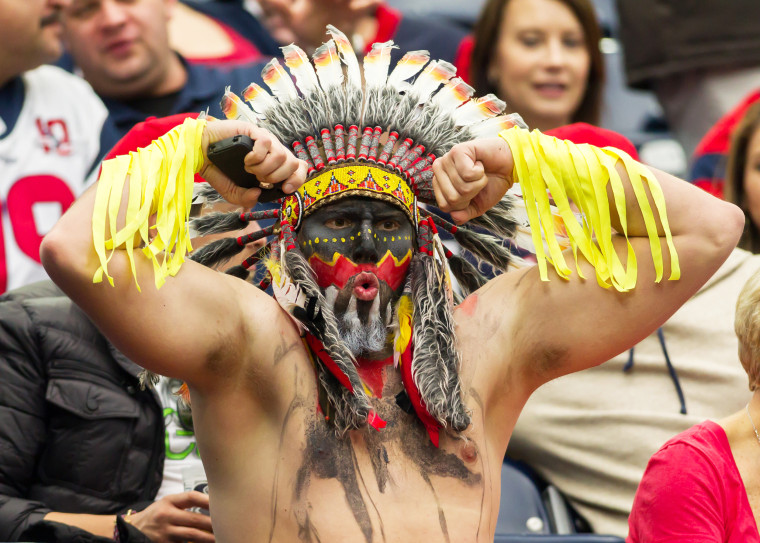Native American mascots might be the last form of traditional American racism that people of every color and creed will rush to support and defend. On any given Sunday during the regular NFL season — right there in the stands — one can find a black guy in a headdress, a white guy in redface, and a Latino or Asian duo tomahawk chopping with one hand and gripping an overpriced alcoholic beverage in the other.
This year, because the Kansas City Chiefs are in the Super Bowl, that time-honored American racism will also be part of what will likely be the most-watched primetime broadcast of the year.
Don’t believe me? Well, just look at the AFC Championship game that sent the Chiefs to the Super Bowl: On Sunday, Jan. 19, they walloped the Tennessee Titans. Yet the most brutal and vicious display that day did not take place on the field but off – and it was a horrid scene to be sure. Chiefs fans whooped while donning fake feathered headdresses, people war-painted their faces and, in that baleful Kansas City tradition, the game began with the beating of that hideous faux “Indian” drum. As its deep boom echoed throughout the stadium, fans performed the tomahawk chop en masse and joined in on that half-witted tomahawk chop “chant.”
There is, however, a tendency — particularly among fans of teams with Native mascots – to assume that it’s only the one with a racial slur that’s problematic. But research suggests that’s not true.
In 2005, the American Psychological Association called for the immediate ban on all Native American mascots, saying that an increasing body of evidence shows that such imagery and language harms not only the “the social identity development and self-esteem of American Indian young people” but also teaches “non-Indian children that it's acceptable to participate in culturally abusive behavior and perpetuate inaccurate misconceptions about American Indian culture.”
In other words, it makes them think it’s OK to perform the tomahawk chop.
Just try, though, to explain that to a Chiefs fan. I did, at a sports bar by me after the Chiefs’ victory on Jan 19. “But ‘Chiefs,’ the team name, isn’t racist,” the fan said to me. “It’s not like the Redskins.”
“No,” I responded. “’Chief,’ the word, isn’t a racial slur, and neither are the names of the Cleveland Indians or Atlanta Braves, but you miss the point.” I went on to explain that Indian mascots dehumanize indigenous people, reducing real human beings into caricatures, costumes, and cartoons.
“How can you see me, or any other Native for that matter, as a human being,” I added, “if sports and Hollywood continue to perpetuate the half-naked, Tonto-talking angry Indian stereotype?” The man didn’t change his mind, or even seem to care. He said he’ll still remain devoted to “his team.”
So I don’t expect Super Bowl LIV between the Kansas City Chiefs and the San Francisco 49ers to be any different than the AFC championship game, or any of the Chiefs games before for that matter.
Native American mascots commodify indigenous peoples and our cultures; they make us and our heritage into images and words and logos to be sold by white people to other non-Native people. It’s a complete and utter appropriation for profit by others.
Indeed, sports fans see such national displays of racism and arrogance on broadcast TV and call it good ol’ American fun, but little do they know (and maybe you don’t either) that there’s a seedy underbelly to that “fun,” and it puts Natives in serious physical danger.
Take the evening of June 15, 2015, for example, when the Chicago Blackhawks won the Stanley Cup. Moments after the news hit, I received a blizzard of messages from a group chat to which I belonged warning its members: “If you’re in the Chicago area stay indoors. The Blackhawks just won the Cup.”
But the fear wasn’t about the possibility of wildly besotted hockey hooligans setting cars ablaze, vomiting on sidewalks from high rise apartments, or ripping down traffic lights in some mad display of team devotion. No, this message was solely for any Native American in Chicago who, unaware of the results of the game, might find themselves in middle of a group of Blackhawk fans who want to keep the name and mascot and might launch into a rage when they see a real Native and assume she or he was the one who wanted a fight.
Such fear isn’t just wild speculation: I lived in Washington D.C. in 2017 and quickly learned that there are certain sports bars into which Native Americans cannot go during football season without sending at least one fan of the city’s racist-themed football team into a vicious rage, barking things like, “Keep the name!” and “I’m a quarter Cherokee and I don’t have a problem with it, you P.C. libtard!”
“Just go somewhere else,” I was once told by a D.C. bartender, as he eyed a few local football fans billowing into a fireball of fury at the end of the restaurant. “We don’t want that kind of trouble here,” he said.
Where have we heard such language before? “Go somewhere else?” I should never have been asked to leave just to accommodate the anger of some racists — but I was.
And that’s where we will be again on Sunday: The discrimination of Natives will continue, and on the main stage. We will be mocked and told to “get over it.” We will be commodified and told things like “we’re honoring you.” But I am here to ruin the party, because that party harms the mental health and stability of kids. Children should be valued over mascots and definitely over cheap team loyalty – every time. Decent people don’t harm kids and they certainly don’t enable anything that would.
Related:





